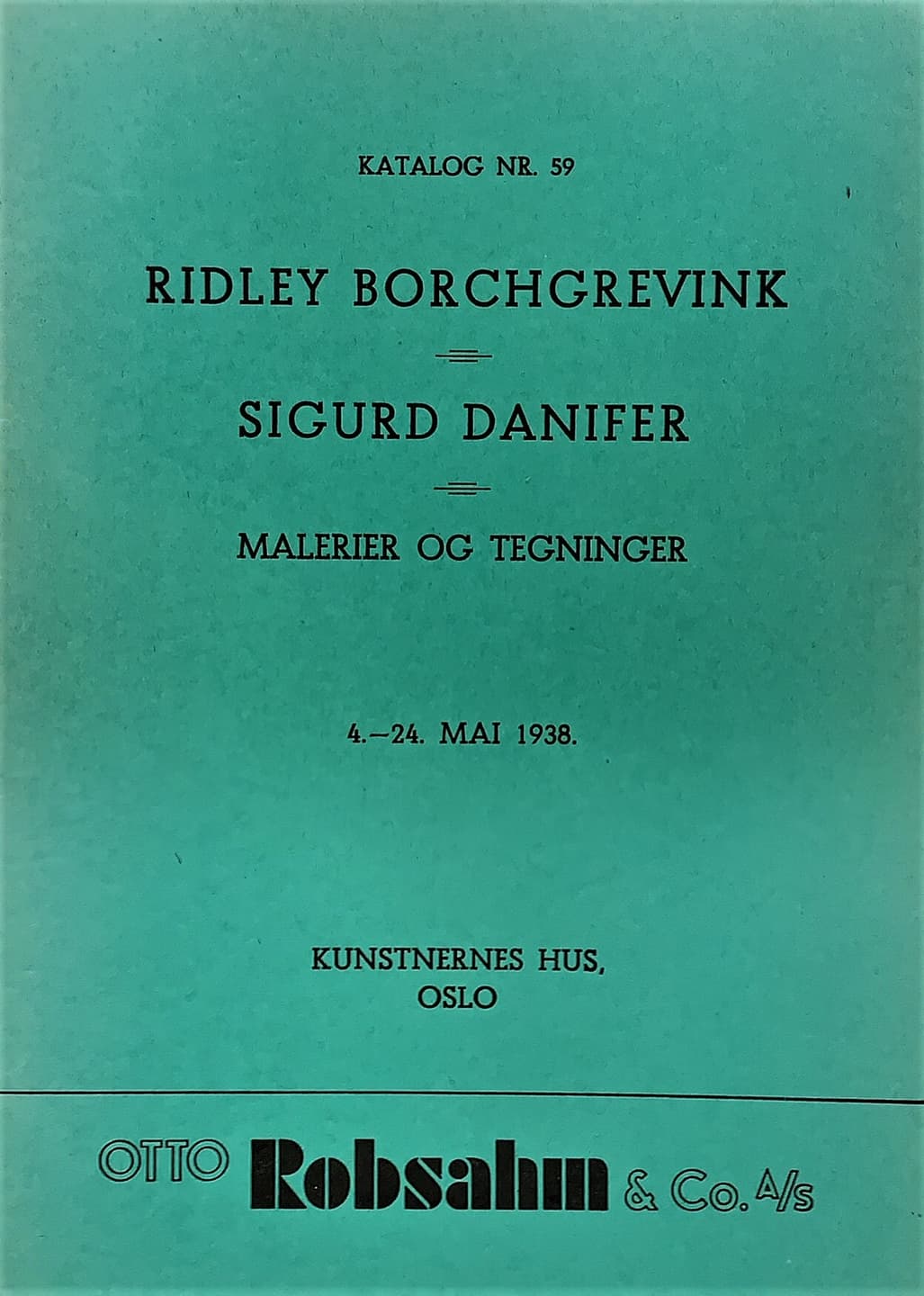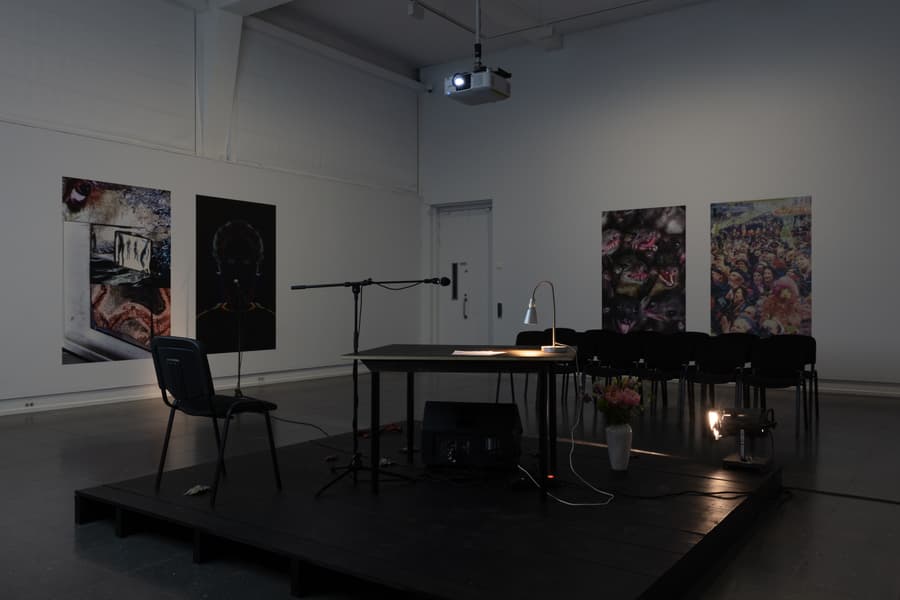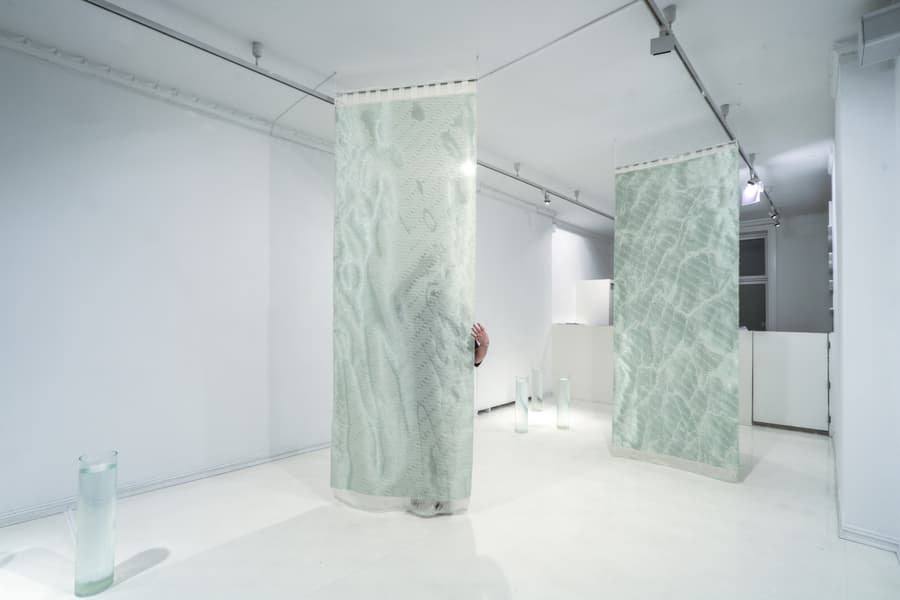Ridley Borchgrevink, Sigurd Danifer

Paintings and drawings
Ridley Borchgrevink
B. was born in England, but came to Norway as early as 1902. While studying in Trondheim, he began to draw and paint, and around 1920 he delivered drawings to Nationen. In Paris 1921, he got little out of the lessons with Friesz and Dufy, while on the other hand he appreciated Lhote as a teacher. From Florence, in the spring of 1921 he contacted Blomqvist Kunsthandel and organized the Young People's Exhibition, which opened on 1 May. With his drawings and two paintings there, and at the same time two paintings at the Spring Exhibition in the Art Association, he already made a strong mark. The critic spoke of his "beautiful dark tapestry-like landscapes" and stated that "this young Painter wants something - it's not just the eternal Apples and Oranges, Small Houses and Self-portraits..." (K.W. in Ørebladet). In Dagbladet, Jappe Nilssen mentioned "a couple of peculiar and profound landscapes", and predicted that "in time he will probably dare to become one of those who will come to mean something in our art of painting". As early as the same autumn (1921), B. had his first solo exhibition, also at Blomqvist's Kunsthandel, and we notice in the newspaper coverage how strongly these romantic fantasies affected the contemporary. Jappe Nilssen wrote: "Not the plain reality, but he knows the adventure, deep, fantastic thickets of forest with an intense eerie atmosphere, and where the trees twist in strange bends and resemble strange prehistoric animals... The most everyday motifs... get a twist of mystery about him, something strange and unlucky". A new exhibition at Blomqvist Kunsthandel 1923 confirmed this impression. The pictures had titles such as Forest interior, Night in the forest, Animals in the forest. The National Gallery acquired two small pictures, Young Man and Ox and Cow, and already the year before, Trøndelag Art Gallery had bought Man with Two Dogs and two drawings. At the Autumn Exhibition in 1922 another characteristic picture, Boy by the Sea, hung. During these years, B. was preoccupied with the old Italian masters with their smooth, finely brushed form and gentle line rhythm, and equally with the Flemish and Dutch painters, especially the animal painters. In 1925 he painted a paraphrase of Rubens' Levkippos' daughters. Of French masters, he himself mentions Poussin and Derain, and Delacroix gradually came to mean a lot to him. The encounter with the East on his great journey in 1924 gave new fuel to his romantic dream, but also gave it more substance. More and more, it was animal life that occupied him, an old love that had been expressed in fine, small drawings from the very beginning. From the journey he brought with him drawings such as the one of a mighty resting bull, a motif from Penang in Malaysia, a primeval forest idyll probably from the same regions, and the moody one of two elephants entwining their trunks, drawn in Bangkok. After returning home, the impressions of exotic nature and wildlife were shaped in large compositions such as Siamese landscape (1925) and At the spring (1931, National Gallery). They express his longing back towards the simple and close to nature, there rests an atmosphere of Arcadian calm and silence over such scenes, with an echo of Poussin. In other pictures from the end of the 1920s, we encounter a violent display of temperament, he painted horses in a wild rush across our native mountain expanses, pictures which are often kept in a gloomy blue-black and inked color. In Løvetemmeren (1927) there is calm and balance again, the wild animal forces tamed in a strict pyramidal composition. After his first encounter with Africa in 1931, we get exotic battle scenes such as Horse and Lion (1931), closely related to Delacroix's lion hunts. African guinea fowls (1932) have a richer color tone, in the juxtaposition of blue and ochre, again with a memory of Poussin.
As an animal artist, B. reached the championship early. His White Egret (1928, National Gallery) is done with incomparable finesse in the soft pencil strokes, and the same applies to A Tern (1938, National Gallery). He had a hit with his book Svart og hvitt i Afrika (1932). This applies to the text and even more so to the many playful drawings: dancing ostriches and antelopes, seasickly swaying giraffes, fluttering guinea fowls, lurking crocodiles and cheeky monkeys. They are all seen with lightning-sharp observation, preferably in the middle of a movement, and are rendered with joyful mood. In a later Africa book, Dyrespor og vill honing (1950), the drawing style has become simpler and more concise, with an emphasis on the outline. The sketchy rapidity is emphasized, the tone is more serious. In both books there are also fine studies of native types that emphasize the gazelle-like slenderness of the negro girls, the sinewy nakedness of the warriors. The drawing African landscape (1948–49), which was not included in the book, has a distinct monumentality. In amusing contrast to the exoticism of the Africa books are the humorous illustrations of P.Chr. Asbjørnsen's Norske huldre-eventyr og folkesagn (1934), based on extensive studies around Eastern Norway, and we can mention the powerful moose drawings in Mikkjel Fønhus' Trollelgen (1947). Just as nicely, B. has immersed himself in Danish, more precisely Jutland, nature in the neat line drawings for the Norwegian edition of Kaj Munk's Liv og glade dager (1946). In total, in the period 1924–55, he illustrated approx. thirty books. He also brought back a rich treasure of drawings from other travels. In 1936 he drew Spanish street scenes with people and donkeys, and in a long series of studies from Portugal 1952–54 he showed his keen eye for the colorful southern folk life. Around 1940 he took up graphics, first woodcuts, later also etching and lithography in black and white and colour. In 1941 he published a folder with five woodcuts, bird motifs "executed with impressive certainty and great decorative sense" (Kr. Sinding-Larsen). Among his lithographs can be mentioned Giraffes (1959), coloristically fine with the animals' pale brown against a light grey-green sky, and in black and white Sleeping Hunting Dog (1961) and Ice Bear (1972). Of the drawings from later years, the many studies of dogs are perhaps best remembered. Here and in other animal studies (horses, goats, etc.) he has nicely captured the nature of the animals, without the violently expressive and almost caricaturing in many of the youth works. The drawing can take on a lapidary simplicity, but he can also give a finely nuanced winter atmosphere, as in the soft pencil drawing of two winter grouse (1971–72). The late paintings usually do not provide much in addition to the drawings; the coloring is often more descriptive than actually image-creating, a picture like Tiurspill (1974, Riksgalleriet) is nevertheless quite beautiful in colour. In an interview from 1971, B. himself aptly characterized the dual nature of his artistic temperament, the longing and the love of home: "Thus I have two homes, one under the acacia tree and one at the root of the fir, and I listen to the rustling of both trees. But the African Pana - the whistle tone now in my age merges with the hiss of the Norwegian spruce forest - and the chirping of the weaver birds in the acacia tree is replaced by many voices from Norwegian bird mountains".
Sigurd Danifer
D. was fully qualified as an electrical engineer and employed at Oslo Elektrisitetsverk when he resigned his position to become an artist. He made it through as a night watchman in Tidens Tegn and Nationen and delivered drawings with Oslo motifs to the latter newspaper. At the Autumn Exhibition, he made his debut as early as 1919 with a drawing. At this time he was very interested in J.C. Dahl, especially of his Italian sketches, and likewise of French art, and he deepened his knowledge of French painting when he was a pupil of A. Lhote in 1922–23. In his own pictures, he cultivated the strict form and a deep-voiced, ascetic color, a manner that critics were not kind to when he debuted at Blomqvist's Kunsthandel in the autumn of 1924. "He suffers from a learned and barren contempt for color. The intention is clearly visible . The whole thing should appear discreet, balanced, classic" (A. Schou in Vor Verden). In 1924, D. declared his love for Poussin and Renoir, and we can add Corot and Cézanne to these. It took some time before he managed to merge these different impressions, but in the late 1920s he won the style that became his own. He settled in Etterstad in Oslo, and here nature's own blond light and fine play of colors came into his pictures, he found "the silver tone in the light in the Oslo valley" (O. Halaas). In pictures such as From Kampen (1929, NG), From Briskeby (1929), From the outskirts of Oslo (1933, NG) and Vår (ca. 1934, Bergen Picture Gallery) he depicted such urban motifs with the untidy buildings, smoking factory pipes, grey-yellow house gables and the sprawling bare trees of the suburban loops against the dirty snow, often with a view of the fjord and the hills around the city under a hazy, lightly veiled sky, the coloring tuned in soft pale yellow, light blue and pink tones. This intimate depiction of Oslo has none of Anders Svarstad's or Reidar Aulie's big-city tristesse. He found another motif circle in Sørlandet, with knotty pines between rock crags (Skjærgårdsfuruer 1936, NG). In such surroundings, he liked to place his summer bathing scenes, naked women's bodies in fine rhythmic interaction and with a modeling that testifies to his study of Renoir. Sometimes, as in Badeplassen (1934) and Summer Day (1939), it turns into complicated, figurative groupings inspired by Cézanne. Or he painted depictions of work such as Slåttefolk (1939), and garden and forest motifs with the meandering and bristling branches of the trees against the snow (Old apple garden, Ensjø, 1952, Vinterdag i Bærum 1953–54). He often also took motifs from the small Italian towns (Italiensk fjellby, 1932), foremost among them Four Pines (1933), where the dark crowns of the trees form an effective contrast against the white town and the distant mountains in the background. In later pictures, such as Ice carving (1938, NG), there is a greater weight and width to the color overlay. Among D.'s few portraits, that of his wife from 1930 stands out, painted with fine psychological sensitivity. Within the group of young painters of the 1920s of the Lhote school, D. stands next to Bernt Clüver as perhaps the finest painterly talent.


